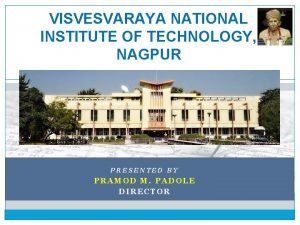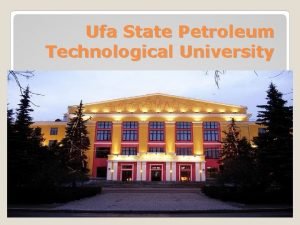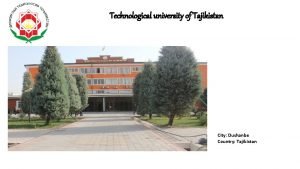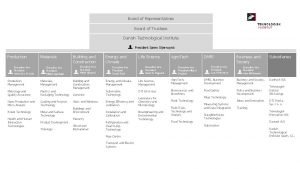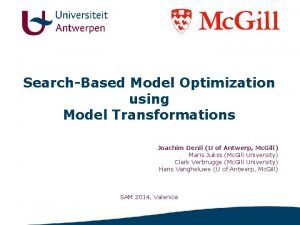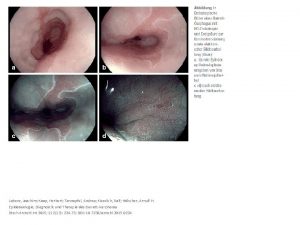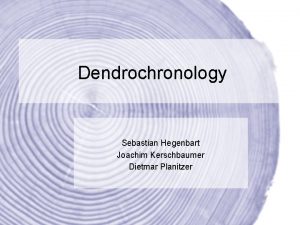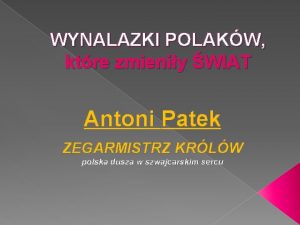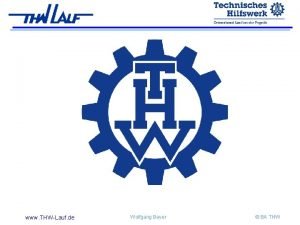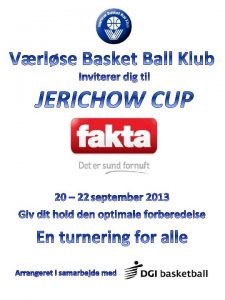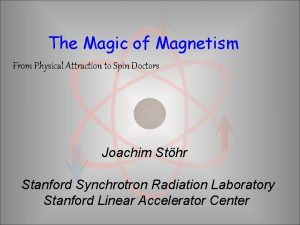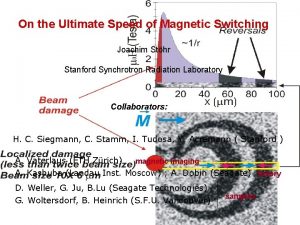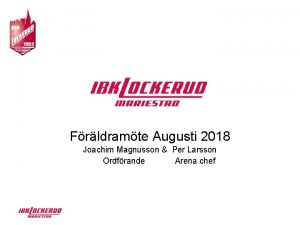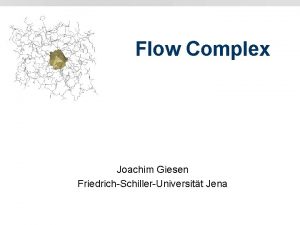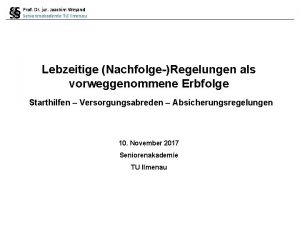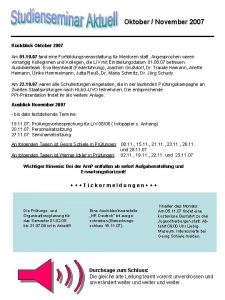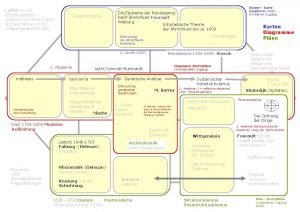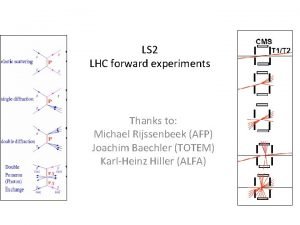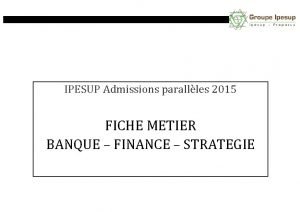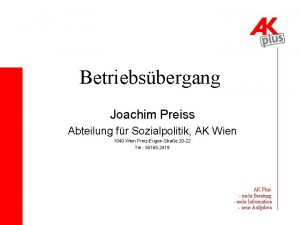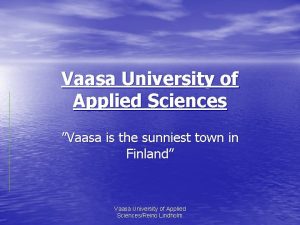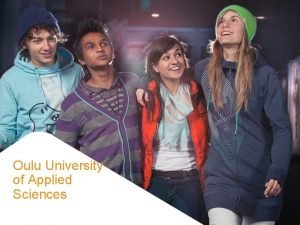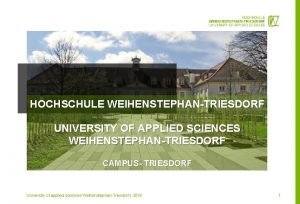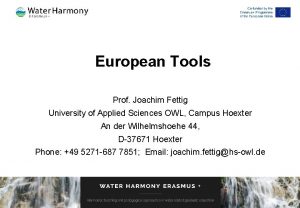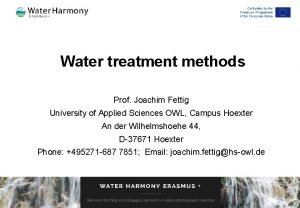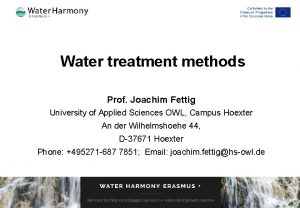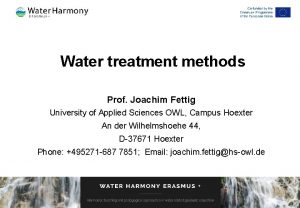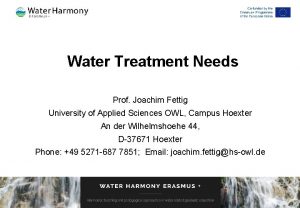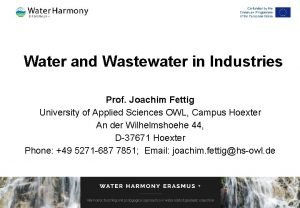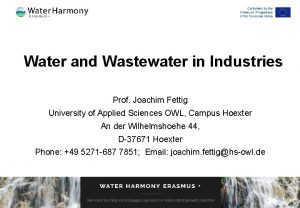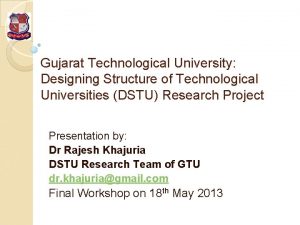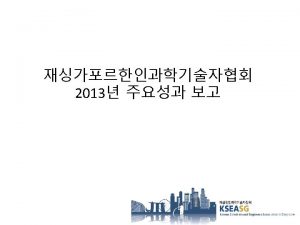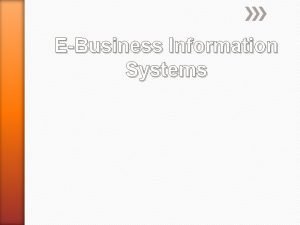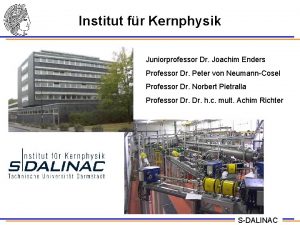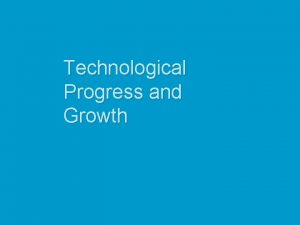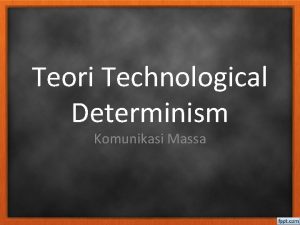Technological Trends Joachim Fettig Professor University of Applied



![Global drivers for technological trends 589 625 [Royan, 2012; updated 2016] Water Supply: Technological Global drivers for technological trends 589 625 [Royan, 2012; updated 2016] Water Supply: Technological](https://slidetodoc.com/presentation_image/3dd3a60c1b0acdb2aefef9d4c5d88a23/image-4.jpg)
![Global drivers for technological trends [Royan, 2012] Water Supply: Technological Trends 5 Global drivers for technological trends [Royan, 2012] Water Supply: Technological Trends 5](https://slidetodoc.com/presentation_image/3dd3a60c1b0acdb2aefef9d4c5d88a23/image-5.jpg)
![Global drivers for technological trends [WIM, 2015] Water Supply: Technological Trends 6 Global drivers for technological trends [WIM, 2015] Water Supply: Technological Trends 6](https://slidetodoc.com/presentation_image/3dd3a60c1b0acdb2aefef9d4c5d88a23/image-6.jpg)





![Ultrafiltration with ceramic membranes Example: Process scheme developed by Metawater Co (Japan) [Metawater, 2018] Ultrafiltration with ceramic membranes Example: Process scheme developed by Metawater Co (Japan) [Metawater, 2018]](https://slidetodoc.com/presentation_image/3dd3a60c1b0acdb2aefef9d4c5d88a23/image-12.jpg)






















- Slides: 34

Technological Trends Joachim Fettig Professor, University of Applied Sciences OWL Harsha Ratnaweera Professor, Norwegian University of Life Sciences

Learning targets § Overview of current technological developments in different areas, both with respect to the optimization of processes and the application of new materials § Becoming familiar with new challenges and solutions in drinking water treatment Water Supply: Technological Trends 2

Outline - Process optimization in general Ultrafiltration with ceramic membranes DBP control by enhanced coagulation Control of organic micro-pollutants UV disinfection improvements Control of emerging inorganic pollutants • • • - Removal of arsenic Removal of nickel Removal of uranium Partial softening by nanofiltration Seawater desalination by reverse osmosis Finals remarks Water Supply: Technological Trends 3
![Global drivers for technological trends 589 625 Royan 2012 updated 2016 Water Supply Technological Global drivers for technological trends 589 625 [Royan, 2012; updated 2016] Water Supply: Technological](https://slidetodoc.com/presentation_image/3dd3a60c1b0acdb2aefef9d4c5d88a23/image-4.jpg)
Global drivers for technological trends 589 625 [Royan, 2012; updated 2016] Water Supply: Technological Trends 4
![Global drivers for technological trends Royan 2012 Water Supply Technological Trends 5 Global drivers for technological trends [Royan, 2012] Water Supply: Technological Trends 5](https://slidetodoc.com/presentation_image/3dd3a60c1b0acdb2aefef9d4c5d88a23/image-5.jpg)
Global drivers for technological trends [Royan, 2012] Water Supply: Technological Trends 5
![Global drivers for technological trends WIM 2015 Water Supply Technological Trends 6 Global drivers for technological trends [WIM, 2015] Water Supply: Technological Trends 6](https://slidetodoc.com/presentation_image/3dd3a60c1b0acdb2aefef9d4c5d88a23/image-6.jpg)
Global drivers for technological trends [WIM, 2015] Water Supply: Technological Trends 6

Process optimisation in general: Coagulation Ballasted coagulation (addition of micro-sand, magnetic particles, etc. ) increases the separation efficiency and speed, as well as reduces the plant’s foot-print. A combination with lamella sedimentation increases the efficiency further. © Actiflo with micro-sand lamella [http: //technomaps. veoliawatertechnologies. com/actiflo/en/] Water Supply: Technological Trends 7

Process optimisation in general: Flotation is quite efficient in utilising the space. Special constructions may further increase the space savings. [http: //www. degremont-technologies. com/cms_medias/pdf/AQUADAF_US_Infilco. pdf] Water Supply: Technological Trends 8

Process optimisation in general: Flotation § Flotation units integrated with lamella plates can increase the efficiency and capacity [http: //www. mwwatermark. com/en_US/slant-plate-dissolved-air-flotation-clarifier/] Water Supply: Technological Trends 9

Ultrafiltration with ceramic membranes Present situation § Ultrafiltration well established during the past 20 years as a process for removing particles and colloids, and even natural organic matter (NOM) § Large treatment plants with production rates of several 100. 000 m 3/d found in many countries today § Application of organic membranes common because of their mechanical robustness and their low price Limitation § Sensitivity of the membranes with respect to oxidizing chemicals § After some years decreased flow rates (flux) because of irreversible fouling processes and aging/compacting of the membranes Water Supply: Technological Trends 10

Ultrafiltration with ceramic membranes Alternative § Application of ceramic membranes made of aluminium oxide, titanium dioxide, zirconium dioxide or carbon composites originally developed for industrial separation processes, § First large-scale plants in Sweden, Luxembourg, Japan and Singapore Advantages § High mechanical strength → increased backwash pressure (up to 5 bars) § High chemical robustness → withstand ozone, e. g. for fouling control § Long operating lifetime (> 15 years) Main disadvantage § Prices 3 -4 times higher than for organic membranes → higher capex Water Supply: Technological Trends 11
![Ultrafiltration with ceramic membranes Example Process scheme developed by Metawater Co Japan Metawater 2018 Ultrafiltration with ceramic membranes Example: Process scheme developed by Metawater Co (Japan) [Metawater, 2018]](https://slidetodoc.com/presentation_image/3dd3a60c1b0acdb2aefef9d4c5d88a23/image-12.jpg)
Ultrafiltration with ceramic membranes Example: Process scheme developed by Metawater Co (Japan) [Metawater, 2018] Water Supply: Technological Trends 12

DBP control by enhanced coagulation Present situation § Natural organic matter (NOM) found in all surface and ground waters § Increase in the amount of NOM observed over the past 10– 20 years in several raw water supplies § Relevance for drinking water: a) colour, taste and odor problems b) increased disinfectant doses resulting in increased production of harmful disinfection by-products (DBPs, e. g. THMs) c) promoted biological growth and deposits in the distribution system d) increased levels of complexed heavy metals and adsorbed organic pollutants Water Supply: Technological Trends 13

DBP control by enhanced coagulation Treatment § Most common and economically feasible: Coagulation and flocculation followed by sedimentation/flotation and sand filtration § Treatment efficiency dependent on the type of NOM § Observation: The hydrophobic fraction and high molar mass compounds of NOM are better removable than the hydrophilic fraction and low molar mass compounds § Requirements (i. e. in the US defined in the Disinfectants and Disinfection Byproduct Rule as of 2006): Enhanced and/or optimized coagulation for better removal of NOM § Further goals: Maximum pathogen removal, low turbidities and particle counts, and minimum residual Al or Fe Water Supply: Technological Trends 14

DBP control by enhanced coagulation Approach § Better process control so the treatment efficiency is improved and remains constant • Optimal coagulant dosage control • Online surveillance of NOM after coagulation Water Supply: Technological Trends 15

DBP control by enhanced coagulation Example § Online monitoring of inlet quality to define the optimal coagulant dosage § Feed-back control / Adjustment of coagulant dosing to obtain best NOM removal Feed-forward control Feed-backward control Water Supply: Technological Trends 16

Control of organic micro-pollutants Present situation § Organic micro-pollutants from industries, personal care products and pharmaceuticals increasingly found in surface waters § Nature-orientated treatment like riverbank filtration not efficient to remove all of these pollutants § Groundwater sometimes contaminated with pesticides Solution Processes which can remove micro-pollutants must be included in conventional treatment trains, in particular → chemical oxidation, first of all ozonation → adsorption on (granular) activated carbon also in combination (see lesson 13, biological activated carbon systems) Water Supply: Technological Trends 17

Control of organic micro-pollutants Example: Upgrading of Essen-Ueberruhr waterworks (Germany) in 2016 § Raw water: Riverbank filtrate from river Ruhr § Capacity: 288. 000 m³/d resp. 75 Mio. m³/a, serving about 1 Mio. people § Upgraded by an ozonation and a granular activated carbon (1. 500 m 3) stage Riverbank filtration Ozonation Filtratiion Activated carbon CO 2 stripping UV-disinfection [Stadtwerke Essen, 2018] Water Supply: Technological Trends 18

UV disinfection – increased lifetime § Present status UV disinfection is a well-known method for inactivation of micro-organisms. The short lifetime of the lamps (2 years) is a cost-driver. § Solution By use of LED technology the lamp lifetime can be increased to >11 years. § Possible problem Disinfection by-products: no THMs, but more exotic ones (still unkown) could be generated. Water Supply: Technological Trends 19

Control of emerging inorganic pollutants Removal of arsenic Problem § Occurance of arsenic of natural origin in groundwater resources all over the world, in some areas at concentrations of several 100 µg/L § WHO guideline value: 10 µg/L § Developed countries: Centralised treatment for arsenic removal needed Technical solutions I. If necessary oxidation of arsenite As(III) to arsenate As(V), then precipitation of As(V) with Fe(III) salts and direct filtration Advantage: Reliable operation possible, high efficiency Disadvantage: Further treatment and disposal of filter backwash wastewater loaded with arsenic bound to Fe(OH)3 flocs required Water Supply: Technological Trends 20

Control of emerging inorganic pollutants Removal of arsenic Technical solutions II. If necessary oxidation of arsenite As(III) to arsenate As(V), then adsorption of As(V) onto granular ferric hydroxide (GFH) in fixed-bed columns Advantages: ► Reliable and very easy operation ► High efficiency ► High capacity (treatment of several 10. 000 bed volumes before breakthrough) Disadvantage: Disposal of exhausted GFH on (non-hazardous) landfills (≈ 5– 25 g/m 3 treated water) GFH has also been applied successfully for removing phosphate (e. g. for the restoration of lakes) and for antimony removal from drinking water Water Supply: Technological Trends 21

Control of emerging inorganic pollutants Removal of arsenic Example GFH-plant in Little Freer, Texas (US), in operation since 2013 Product: Bayoxide E 33 ferric oxide Plant: 3 columns with one operating in parallel and the other two in series; total flow rate = 200 m 3/h Raw water concentration = 34 µg/L Treated water concentration < 10 µg/L Throughput before replacement of adsorbent ≈ 50. 000 bed volumes Water Supply: Technological Trends GFH plant [WWD, 2014] 22

Control of emerging inorganic pollutants Removal of nickel Problem § Occurance of nickel Ni 2+ of natural origin in groundwater resources in Europe, at concentrations of several 10 µg/L § WHO guideline value: 70 µg/L § Maximum allowable concentration in the EU: 20 µg/L Technical solution Application of selective ion exchange resins (chelate cation exchanger) originally developed for industrial wastewater treatment, in fixed-bed columns Advantages: Reliable operation, high capacity → long service life External regeneration of exhausted ion exchange resins Water Supply: Technological Trends 23

Control of emerging inorganic pollutants Removal of nickel Example Small waterworks in Germany, upgraded for nickel removal in 2012 Product: Chelate cation exchanger, conditioned with calcium ions Plant: 4 columns operating in parallel; total flow rate = 100 m 3/h Hydraulic loading rate = 22 m/h Raw water concentration = 45 µg/L Treated water concentration < 5 µg/L Specific costs = 0. 043 €/m 3 Nickel removal plant [Walter, et al. , 2015] Water Supply: Technological Trends 24

Control of emerging inorganic pollutants Removal of uranium Problem § Occurance of uranium of natural origin as U(VI), e. g. UO 2(CO 3)22 -, in groundwater resources all over the world, at concentrations of several 10 µg/L § WHO guideline value: 30 µg/L because of toxicity, not because of radiation § Maximum allowable concentration in Germany: 10 µg/L Technical solution Application of selective ion exchange resins (strong basic anion exchanger) in fixed-bed columns, effluent concentrations < 0. 1 µg/L Advantages: Reliable operation, high capacity → long service life External regeneration of exhausted ion exchange resins Water Supply: Technological Trends 25

Control of emerging inorganic pollutants Removal of uranium Example Waterworks Hirschaid in Germany, upgraded for uranium removal in 2007 Product: Uranex anion exchanger Plant: 1 column; maximum flow rate = 58 m 3/h Hydraulic loading rate up to 40 m/h Raw water concentration = 37 µg/L Treated water concentration < 1 µg/L Service life of the resin ≥ 1. 5 a Ion exchanger for uranium removal in Hirschaid [Veolia Water, 2018] Water Supply: Technological Trends 26

Partial softening by nanofiltration Present situation § High hardness in groundwater in different parts of the world, i. e. the sum of dissolved calcium and magnesium is higher than 2. 5 mmol/L (corresponding to 250 mg/L of calcium carbonate) § No maximum allowable values for hardness in drinking water but some drawbacks for consumers, e. g. precipitation of calcite in hot water systems and high demand of detergents § Technical solution: Centralised softening of hard raw water by lime softening, ion exchange, or nanofiltration (membranes with cut-off < 400 -500 Daltons) Removal of calcium and magnesium ions by nanofiltration General description of membrane processes → see lesson 10 Operating conditions: Cross-flow, thus disposal of concentrate necessary Water Supply: Technological Trends 27

Partial softening by nanofiltration Operating parameters: § § § § Recovery = 75 -80% (single-stage process), up to 85% (two-stage process) Operating pressure = 2 -12 bar Flux rate = 15 -50 (L/(m 2·h)) {Average in Germany: 24 (L/(m 2·h)) at 10 -12 °C} Rejection of magnesium sulphate usually ≥ 90%, therefore also sidestream treatment for partial softening common Prevention of scaling (in particular with respect to barium and strontium) by dosing of anti-scalants Post-treatment: Removal of carbon dioxide by aeration or calcite filters Operating lifetime of the membranes = 3 -5 years Specific energy consumption usually < 0. 5 k. Wh/m 3 {Average in Germany: 0, 32 k. Wh/m 3 } Water Supply: Technological Trends 28

Partial softening by nanofiltration Example: Upgrading of Karlstein waterworks (Germany) in 2009 Raw water: Shallow groundwater, hardness = 3. 6 -3. 9 mmol/L Product: TORAY Polyamide Composite membrane Maximum flow rate = 85 m 3/h Operating pressure = 9 bar Recovery > 80% Treated water hardness < 1. 8 mmol/L Post-treatment: CO 2 -removal by aeration Nanofiltration plant for partial softening in Karlstein [Toray Membrane Europe, 2009] Water Supply: Technological Trends 29

Seawater desalination by osmosis Present situation Reverse Osmosis (RO) has been used over several decades for seawater desalination. However, the energy costs are a big challenge to the widespread use of this technology. Solutions § Mixing of seawater with water reclaimed from wastewater reuse processes to dilute salt in the seawater before RO. Thus pumping costs are reduced since the diluted seawater can be pumped through the filtering process at lower pressure (>30% reduction of power usage, Hitachi®) § Forward Osmosis induces a net flow of water through the membrane from seawater to the permeate. The reverse osmosis process uses hydraulic pressure, while forward osmosis uses the osmotic pressure gradient as the driving force for separation. § Various research and applications show a remarkable reduction of energy using “recuperators”. The energy consumption could be below 2 k. Wh/m 3 compared with 20 k. Wh/m 3 in the 1970’s. The theoretical minimum is 1 k. Wh/m 3 (American Membrane Technology Association). Water Supply: Technological Trends 30

Final remarks General trends regarding the design and operation of treatment processes: - Intensified process surveillance and automation - Increased application of process simulation tools and on-line control instruments - Reduction of the amount of chemicals added during treatment - Introduction of Technical Safety Management structures to water abstraction, treatment, and distribution - Implementation of Water Safety Plans - Strengthening of the multiple-barrier principle - Improving efficiency of seawater desalination by energy recuperators, forward osmosis etc. Water Supply: Technological Trends 31

Questions § Summarize briefly five important drivers for technological developments in drinking water treatment. § Which improvements have recently been achieved in designing and operating the coagulation and flocculation process? § What kind of modifications and new applications have been found for membrane processes (UF, NF and RO), respectively? § Which new solutions are available for the separation of organic micro-pollutants and the inactivation of micro-organisms? § Which techniques have been developed for removing arsenic, nickel and uranium as emerging inorganic pollutants? Water Supply: Technological Trends 32

References Metawater 2018 http: //www. metawater. co. jp/eng/product/plant/water/membrane_clarify/, accessed February 2018 Royan, F. : Sustainable Water Treatment Technologies in the 2020 Global Water Market. Investor Briefing, 15. 03. 2012. http: //www. forburyinvest. com/fileuploads/Frost%20&%20 Sullivan. pdf, accessed April 2018 Royan, F. : Global Water Market Outlook. British Water International Forum Meeting, 13. 10. 2016. www. britishwater. co. uk/Media/Download. aspx? Media. Id=1055, accessed April 2018 Stadtwerke Essen: https: //www. stadtwerke-essen. de/fileadmin/user_upload/Grafiken/Schritte_ Wasseraufbereitung_2016. jpg, accessed February 2018 Toray Membrane Europe: Nanofiltration enthärtet Brunnenwasser. wwt (2009), 7 -8, 15 http: //www. wwt-online. de/sites/default/files/fachartikel/nutzung_alternativer_wasserressourcen_ wwt_0709. pdf, accessed February 2018 Veolia Water: http: //www. veoliawatertechnologies. de/info-center/referenzen/ uranentfernung-aus-trinkwasser-mit-uranex-in-gemeinde-hirschaid. htm , accessed February 2018 Water Supply: Technological Trends 33

References Walter, P. , Magay, P. and Beforth, H. : Neubau und erste Betriebserfahrungen einer Entnickelungsanlage für die Trinkwasserversorgung. bbr (2015), 10, 50 -57 WIM: Water Innovations – The TOP 10 Trends of 2015. Water Innovations Magazine, March 2015, www. wateronline. com/doc/water-innovations-the-top-trends-of-0001, accessed February 2018 WWD: Adsorbing Arsenic. Water & Waste Digest, November 2014, https: //files. wwdmag. com/s 3 fs-public/11. 14_AA 3_Severn. Trent. pdf, accessed February 2018 Water Supply: Technological Trends 34
 Promotion from assistant to associate professor
Promotion from assistant to associate professor Visvesvaraya technological university nagpur
Visvesvaraya technological university nagpur Ufa state petroleum technical university
Ufa state petroleum technical university Technological university of tajikistan
Technological university of tajikistan Danish technological university
Danish technological university Clark verbrugge
Clark verbrugge The bloodline of jesus
The bloodline of jesus Joachim koop
Joachim koop Sebastian hegenbart
Sebastian hegenbart Pronote authon du perche
Pronote authon du perche Joachim de zutter
Joachim de zutter Joachim bovin
Joachim bovin Joachim frisch karlsruhe
Joachim frisch karlsruhe Antoni zegarmistrz
Antoni zegarmistrz Joachim süß
Joachim süß Joachim jerichow
Joachim jerichow Joachim dejaco
Joachim dejaco Magnetism
Magnetism Joachim stöhr
Joachim stöhr Joachim stöhr
Joachim stöhr Joachim magnusson mariestad
Joachim magnusson mariestad Joachim haeberlen
Joachim haeberlen Joachim giesen jena
Joachim giesen jena Joachim weyand
Joachim weyand Joachim grußdorf
Joachim grußdorf Joachim da fiore
Joachim da fiore Joachim baechler
Joachim baechler Joachim savigny
Joachim savigny Johann joachim winckelmann
Johann joachim winckelmann Joachim krebser
Joachim krebser Joachim preiss
Joachim preiss Van hall larenstein university of applied sciences
Van hall larenstein university of applied sciences Vaasa university of applied sciences
Vaasa university of applied sciences Oulu university of applied sciences
Oulu university of applied sciences Hswt student service
Hswt student service

